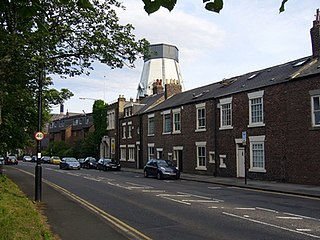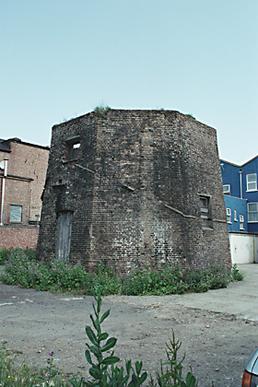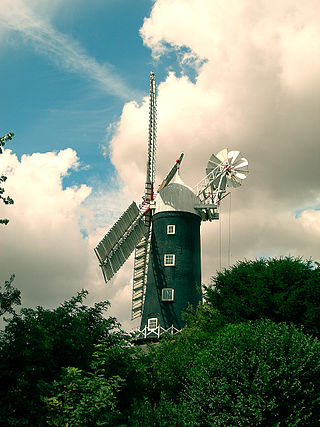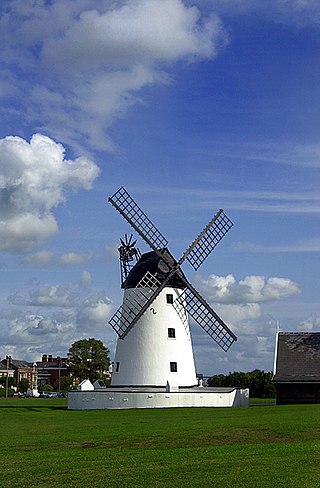
Mount Pleasant Mill is a windmill north of Kirton in Lindsey on the North Cliff Road in North Lincolnshire in the east of England.

Acaster Selby is a village in the former Selby District of North Yorkshire, England. It is part of the joint civil parish with Appleton Roebuck. It is situated about 6 miles (9.7 km) south from York, on the west back of the River Ouse; near the opposite bank is the settlement of Stillingfleet, and 1.3 miles (2.1 km) to the north-west is Appleton Roebuck.

Appleton Roebuck is a village and civil parish in the former Selby District of North Yorkshire, England. The village is about 9 miles (14 km) south-west of York. The civil parish includes the hamlets of Holme Green and Nun Appleton, and covers an area of around 2,900 acres (1,200 ha). The parish had a population of 692 according to the 2001 census, increasing to 871 in the 2021 census and including Acaster Selby.

Spital Tongues is a district of Newcastle upon Tyne, located due north-west of the Newcastle City Centre. Its unusual name is believed to be derived from spital – a corruption of the word hospital, commonly found in British place names - and tongues, meaning outlying pieces of land. North of Spital Tongues is the Town Moor, while Castle Leazes and Leazes Park are to the East.

Grassthorpe is a hamlet and civil parish in the Newark and Sherwood district of Nottinghamshire, England. Population from the 2021 census was 55 residents.

Murrays' Mills is a complex of former cotton mills on land between Jersey Street and the Rochdale Canal in the district of Ancoats, Manchester, England. The mills were built for brothers Adam and George Murray.

Sarre Windmill is a Grade II listed smock mill in Sarre, Kent, England, that was built in 1820. Formerly restored and working commercially, the mill is now closed.

Great Mill or Ride's Mill is a Grade II listed smock mill just off the High Street in Sheerness, Kent, England, that was demolished in 1924, leaving the brick base standing. It now has a new smock tower built on it as residential accommodation.

Beacon Mill or New Mill is a grade II listed smock mill at Rottingdean, Sussex, England which has been restored as a seamark. It sits within the boundary of the Beacon Hill Local Nature Reserve.

Skidby Windmill is a Grade II* listed windmill at Skidby near Beverley, in the East Riding of Yorkshire, England.

The city of Canterbury in Kent, England has been served by mills over the centuries. These include animal engines, watermills and windmills.

Langstone Windmill is a Grade II listed tower mill at Langstone, Hampshire in England. It has been converted to residential accommodation.

The former York railway station served the city of York, England between 1841 and 1877. It is a Grade II* listed building.

Nun Appleton Priory was a priory near Appleton Roebuck, North Yorkshire, England. It was founded as a nunnery c. 1150, by Eustace de Merch and his wife. It was dissolved by 1539, when the nuns were receiving pensions.

Swan Lane Mills is a former cotton mill complex in Bolton, Greater Manchester, England. All three mills are Grade II* listed buildings. The mills were designed by Stott and Sons of Oldham. When completed, the double mill was the largest spinning mill in the world. It was granted Grade II* listed status on 26 April 1974. Number 3 Mill was separately listed as Grade II* on the same day.

Lytham Windmill is situated on Lytham Green in the coastal town of Lytham St Annes, Lancashire, England. It is of the type known as a tower mill and was designed for grinding wheat and oats to make flour or bran. Since commercial milling on the site ceased in 1921 the mill has belonged to the town and is operated by Fylde Borough Council, who open it to the public during the summer. The mill also contains a museum run by the Lytham Heritage Trust which explains the history and practice of flour milling.

Drummond Mill was a complex of industrial buildings on Lumb Lane, Manningham, Bradford, West Yorkshire. It contained originally a spinning mill, a warehouse, a spinning shed, and an engine house with chimney and was destroyed in a fire on 28 January 2016.

St John's Church is an Anglican church in Acaster Selby, a village south of York, in England.
Appleton Roebuck is a civil parish in the former Selby district of North Yorkshire, England. It contains twelve listed buildings that are recorded in the National Heritage List for England. All the listed buildings are designated at Grade II, the lowest of the three grades, which is applied to "buildings of national importance and special interest". The parish contains the village of Appleton Roebuck and the surrounding countryside. The listed buildings in the village include houses, a public house, a church, a chapel and a war memorial. Outside the village they consist of a former windmill, a farmhouse and farm buildings, and a small country house.

All Saints' Church is the parish church of Appleton Roebuck, a village south-west of York, in England.




















